Ipanema |
|||||||||||||||||||||||||
 |
 |
||||||||||||||||||||||||
Crocheted top with clover and lace pattern. The piece is worked in DROPS Cotton Light. Sizes S - XXXL.
DROPS 190-2 |
|||||||||||||||||||||||||
|
INFORMATION FOR THE PATTERN: PATTERN: See diagrams A.1 to A.4. CROCHET INFO-1: The first row on each clover leaf (= 1 treble crochet, 3 chain stitches, 1 treble crochet, 3 chain stitches, 1 treble crochet, 3 chain stitches, 1 treble crochet in the same treble crochet) is worked in the middle double treble crochet of the previous clover leaf - see A.2. CROCHET INFO-2: The first treble crochet at the beginning of the row/round is replaced by 3 chain stitches. Finish the row/round with 1 slip stitch in the 3rd chain stitch at the beginning of the row/round. The first double crochet at the beginning of the row is replaced by 1 chain stitch. ---------------------------------------------------------- TOP: First the clover pattern is worked from side to side at the bottom, then the top is worked upwards in the round as far as the armholes. Here the piece is divided and the front and back pieces are worked separately. Work 12 chain stitches (including 5 chain stitches to turn) with Cotton Light and hook size 3.5 mm. Read CROCHET INFO-1! Continue by working according to A.1 until you have worked 1 repeat in height. Then repeat rows 7-12 until the piece measures approx. 100-106-112-124-136-148 cm – finish after row 12. Sew the clover edge together to make a ring (seam = side of the top). Then continue working upwards in the round, THE PIECE IS NOW MEASURED FROM HERE! Crochet up 198-210-222-246-270-294 treble crochets around the treble crochets from the long-side in A.1. Then work according to A.3 – read CROCHET INFO-2. Continue this pattern upwards. Insert 2 marker threads in the piece, 1 at the beginning of the round and 1 after 99-105-111-123-135-147 treble crochets (= sides). When the piece measures 2 cm decrease 1 treble crochet group (= 3 treble crochets or 1 treble crochet + 2 chain stitches) in each side, decrease before both marker threads. Diagram A.4 shows how to decrease in the pattern. Repeat the decrease upwards every 4 cm; decrease alternately before and after the marker threads in the sides, i.e. the first time you decrease 1 treble crochet group before the marker threads, the second time you decrease 1 treble crochet group after both marker threads. Decrease a total of 6 times in each side of the top = 162-174-186-210-234-258 treble crochets/chain stitches. When the piece measures 25-26-27-28-29-30 cm, adjust so that the next round to be worked is the first round in A.3, divide the piece for the front and back pieces. Cut the strand. FRONT PIECE: Skip the first 6-6-9-12-18-21 treble crochets, work A.3 over the next 70-76-76-82-82-88 treble crochets (= 23-25-25-27-27-29 repeats of A.3 + 1 treble crochet). Turn and work back. Continue this pattern upwards. When the piece measures 36-38-40-42-44-46 cm work over just the first 19-22-22-22-22-25 treble crochets/chain stitches on the row = right shoulder. Continue until the piece measures 42-44-46-48-50-52 cm, cut and fasten the strand. Work the left shoulder in the same way, i.e. work over just the last 19-22-22-22-22-25 treble crochets/chain stitches on the row. The 32-32-32-38-38-38 treble crochets/chain stitches not worked = neck. The piece measures a total of 54-56-58-60-62-64 cm. BACK PIECE: Skip the first 11-11-17-23-35-41 treble crochets after the front piece, work A.3 over the next 70-76-76-82-82-88 treble crochets (= 23-25-25-27-27-29 repeats of A.3 + 1 treble crochet). Turn and work back (there are now 11-11-17-23-35-41 treble crochets in each side which are not worked (= armholes). Continue A.3 upwards. When the piece measures 30-32-34-36-38-40 cm divide the back piece so that you have a split mid back. RIGHT BACK PIECE: Now work over just the first 35-38-38-41-41-44 treble crochets; work A.3 over the first 33-36-36-39-39-42 treble crochets/chain stitches and finish with 2 treble crochets towards mid back. When the piece measures 36-38-40-42-44-46 cm work over just the first 19-22-22-22-22-25 treble crochets/chain stitches on the row = right shoulder. The 16-16-16-19-19-19 treble crochets not worked = neck. Continue until the piece measures 42-44-46-48-50-52 cm, cut and fasten the strand. LEFT BACK PIECE: Now work over just the last 35-38-38-41-41-44 treble crochets; work 1 treble crochet towards mid back, work A.3 over the next 33-36-36-39-39-42 treble crochets/chain stitches and finish with 1 treble crochet towards the side. When the piece measures 36-38-40-42-44-46 cm work over just the last 19-22-22-22-22-25 treble crochets/chain stitches on the row = left shoulder. The 16-16-16-19-19-19 treble crochets not worked = neck. Continue until the piece measures 42-44-46-48-50-52 cm, cut and fasten the strand. ASSEMBLY: Sew the shoulder seams. CROCHET EDGE AROUND THE ARMHOLES: Start at bottom of armhole. Work 1 double crochet,* skip forward approx. 2 cm, work 7 treble crochets around the next treble crochet, skip forward approx. 2 cm, work 1 double crochet around the next treble crochet *, repeat from *-* and finish with 1 slip stitch in the double crochet at the beginning of the round. Work in the same way around the other armhole. CROCHET EDGE AROUND THE NECK: Start mid back. Work 1 double crochet, * 3 chain stitches, skip forward approx. 1 cm, work 1 double crochet *, repeat from *-*. ASSEMBLY -2: Sew a button to the top of the split mid back; the button is buttoned through 2 treble crochets. |
|||||||||||||||||||||||||
Diagram explanations |
|||||||||||||||||||||||||
|
|||||||||||||||||||||||||

|
|||||||||||||||||||||||||
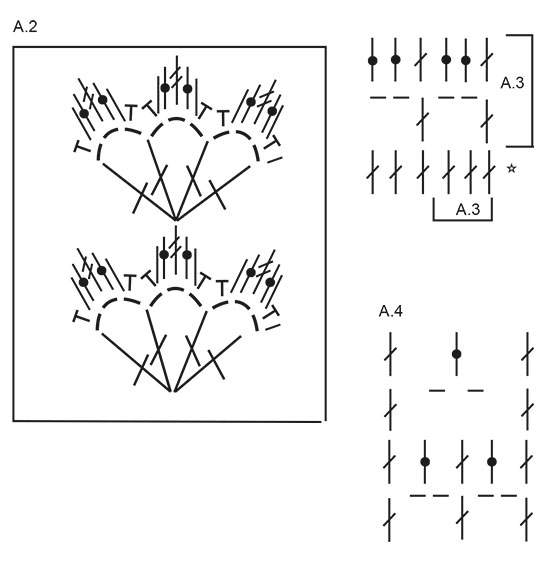
|
|||||||||||||||||||||||||
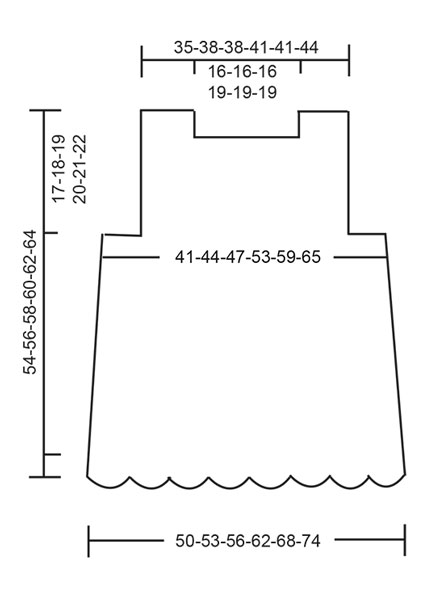
|
|||||||||||||||||||||||||
|
Have you made this or any other of our designs? Tag your pictures in social media with #dropsdesign so we can see them! Do you need help with this pattern?You'll find tutorial videos, a Comments/Questions area and more by visiting the pattern on garnstudio.com. © 1982-2024 DROPS Design A/S. We reserve all rights. This document, including all its sub-sections, has copyrights. Read more about what you can do with our patterns at the bottom of each pattern on our site. |
|||||||||||||||||||||||||







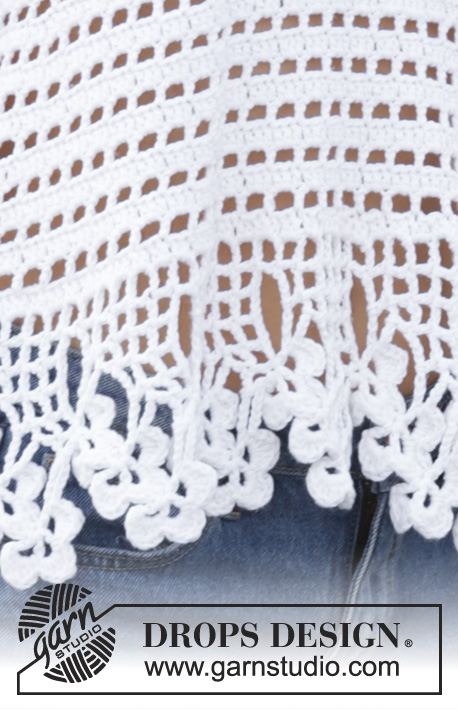




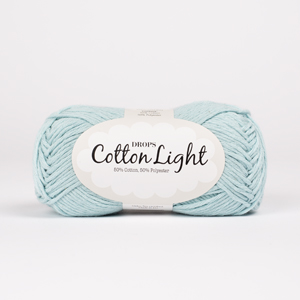









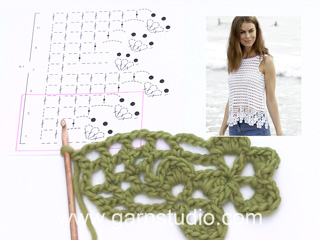





















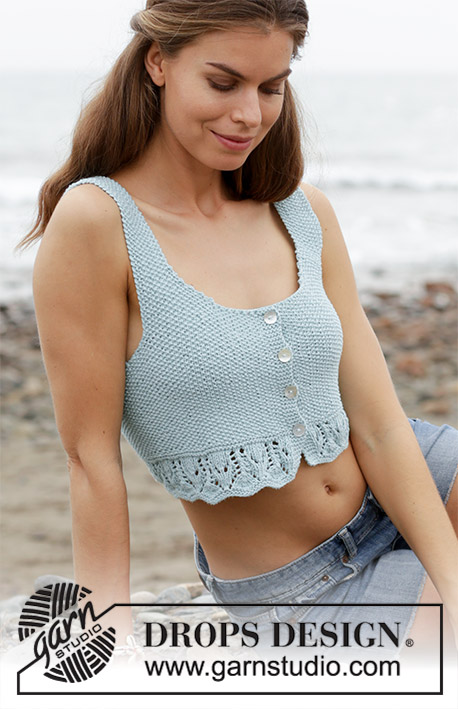






Comments / Questions (40)
I am having difficulty with the A.1 pattern. I have done the first set of crochets but don\'t know where to go from here. Is there a better way to describe how this area is crocheted?\r\nThanks
08.08.2018 - 20:07DROPS Design answered:
Dear Mrs Goldstein, after you have worked A.1 one time in height (= to row 12 included), start again with row 7 (read row 7 from the left towards the right) and repeat row 7 to 12 until measurement for your size, but make sure to finish after a row 12. Happy crocheting!
09.08.2018 - 08:36Haciéndolo así pasamos de 7 puntos a 3, es decir, se disminuyen 4 puntos no 3. Al hacer esto 6 veces a cada lado disminuimos 48 en total y nos quedamos con 174 puntos una vez finalizamos las disminuciones no 186 como dice. Algo no está correcto o no acabo de entenderlo.
31.07.2018 - 12:52DROPS Design answered:
Hola Marian. Mandé tu pregunta al departamento de diseño para que revisen el diagrama. Cuando, por ejemplo, te toca disminuir en la fila de 1 punto alto + 2 puntos de cadeneta tienes que saltar 5 puntos altos de la vuelta anterior, es decir, trabajas 1 punto alto en el punto alto de la vuelta anterior + 2 puntos de cadeneta, saltas 5 puntos altos ( 3 puntos altos de un grupo y 2 puntos altos que sustituyen 2 puntos de cadeneta ) y trabajas el siguiente punto alto en el sig punto alto. El arco queda más grande por eso se hacen las disminuciones a cada lado en modo alterno.
07.08.2018 - 21:16Buenos días: No entiendo cómo hacer las disminuciones. El gráfico no está nada claro ya que no disminuye grupos de 3 punto o 1 punto y 2 cadenetas. ¿Me lo puedes aclarar? Muchas gracias
23.07.2018 - 11:55DROPS Design answered:
Hola Marian. El diagrama A.4 te muestra como se trabajan las disminuciones: Fila 1: 1 p.a., 2 p.de cad., 1 p.a., 2 p.de cad. 1 p.a.(= 7 pts) Fila 2: 5 p.a. (= 5 pts) Fila 3: 1p.a., 2 p.de cad., 1 p.a. (= 4 pts) Fila 4: 3 p.a. (= 3 pts)
31.07.2018 - 12:28Det drejer sig om hvordan man laver indtagningerne. På diagram A4 er der kun vist 2 masker i dtaget på række nr 2. Skal man så bare tage 1 maske ind de sidste 3 gange man hækler A3 inden siden? Hvad så hvis man laver en række med luftmaske buer, skal man så springe 3 masker over de sidste 3 gange man hækler A3 inden siden? A4 synes jeg man starter med 2 “huller” og ,an slutter med 2 “huller”. Der er ikke taget noget ind.....det er nok mig der forstår diagrammet forkert :-)
18.07.2018 - 19:24Scusa voglio chiedere se i numeri che ci sono sul modello si riferiscono ai punti e di conseguenza anche alle taglie S,M,L ecc. \r\nGrazie
05.07.2018 - 11:49DROPS Design answered:
Buongiorno Severina, i numeri separati dal trattino indicano le maglie per le diverse taglie. Buon lavoro!
05.07.2018 - 12:00Har i denne opskrift der skal strikkes? På forhånd tak.
04.07.2018 - 10:30DROPS Design answered:
Hei Lone. Nei, denne oppskriften finnes bare heklet dessverre. Om du vil ha strikkete topper med hullmønster kan du se på for eksempel 170-24 eller 188-22. Du kan også søke spesifikt med «hullmønster» for å få opp alle plaggene med dette. God fornøyelse.
06.07.2018 - 09:15Quanti gomitoli bisogna ordinare x una taglia m
29.06.2018 - 16:44DROPS Design answered:
Buonasera Laura, per una taglia M servono 350g. Ogni gomitolo di Cotton Light è di 50g, per cui ne servono circa 7. Buon lavoro!
29.06.2018 - 21:12¿Realmente este modelo está tejido con Cotton Light? Estoy intentando hacerlo y es imposible conseguir la tensión indicada con este hilo, es demasiado grueso. He tratado de hacerlo con un ganchillo más fino, pero es muy difícil, el hilo se abre en hebras y se engancha todo el tiempo. ¿No sería Muskat, por ejemplo, un hilo más adecuado? Gracias.
18.06.2018 - 22:28DROPS Design answered:
Hola Maribel. La tensión y el número de ganchillo son solo una recomendación. Tienes que hacer pruebas para encontrar la tensión adecuada para el modelo. Es cierto que este hilo tiene la tendencia a separarse debido a las características suaves y sedosas de las hebras y hay que tener cuidado trabajando con ganchillo. Si, puedes trabajar este modelo con Muskat. Los dos son del misma grupo de lanas y se sustituyen fácilmente.
23.06.2018 - 20:12Camelia wrote:
Love this tank! Probably name it "Flower Lace Tank"?
28.12.2017 - 13:03Very nice combination of geometric and floral elements.
28.12.2017 - 11:20